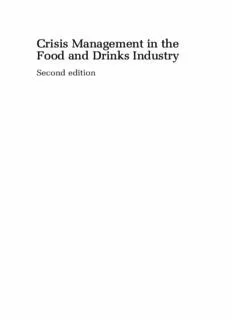
Crisis Management in the Food and Drinks Industry: A Practical Approach (Practical Approaches to Food Control and Food Quality Series) PDF
Preview Crisis Management in the Food and Drinks Industry: A Practical Approach (Practical Approaches to Food Control and Food Quality Series)
Crisis Management in the Food and Drinks Industry Second edition Crisis Management in the Food and Drinks Industry A practical approach Second Edition Colin Doeg LibraryofCongressCataloging-in-PublicationData Doeg,Colin. Crisismanagementinthefoodanddrinksindustry:apracticalapproach/ byColinDoeg.—2nded. p. cm. Includesbibliographicalreferencesandindex. ISBN0-387-23382-2 1.Foodindustryandtrade—Management. 2.Beverageindustry—Management. 3.Crisismanagement. I.Title. HD9000.5.D5972005 664(cid:1).0068(cid:1)4—dc22 2004065092 AC.I.P.CataloguerecordforthisbookisavailablefromtheLibraryofCongress. ISBN0-387-23382-2 (cid:2)C2005SpringerScience+BusinessMedia,Inc. Allrightsreserved.Thisworkmaynotbetranslatedorcopiedinwholeorinpartwithoutthe writtenpermissionofthepublisher(SpringerScience+BusinessMedia,Inc.,233SpringStreet, NewYork,NY10013,USA),exceptforbriefexcerptsinconnectionwithreviewsorscholarly analysis.Useinconnectionwithanyformofinformationstorageandretrieval,electronic adaptation,computersoftware,orbysimilarordissimilarmethodologynowknownorhereafter developedisforbidden. Theuseinthispublicationoftradenames,trademarks,servicemarksandsimilarterms,evenif theyarenotidentifiedassuch,isnottobetakenasanexpressionofopinionastowhetherornot theyaresubjecttoproprietaryrights. PrintedintheUnitedStatesofAmerica. 9 8 7 6 5 4 3 2 1 springeronline.com Contents Serieseditor’sforeword ix Acknowledgements xiii Preface xv 1 Theanatomyofacrisis 1 2 Protectingyourbrandsandreputation 11 2.1 Designinghazardsoutofasystem 16 2.2 Needforriskassessmentprocedures 19 2.3 Benefitsof‘duediligence’ 20 2.4 Marketersbeware 20 2.5 Benefitsofcorporatecitizenship 21 3 Preparingfortheunthinkable 23 3.1 Threatstotakeintoaccount 24 3.2 Firsthintofaseriousproblem 26 3.3 Sourcesofhelpandadvice 28 3.4 Checklistforcrisisteam 30 3.5 Nomagicsolutions 32 3.6 Crisis,whatcrisis? 33 3.7 Feelandinstinct 34 4 TheInternet—atwo-edgedsword 37 5 Tacticstoavoidbeingcaughtoff-guard 49 6 Producttampering—aconstantthreat 57 6.1 Keepingissuesinperspective 58 7 Issuestrackingandmanagement 65 7.1 Anorchestratedcampaign 66 7.2 Asuspectingredient 68 7.3 Puttingmattersinperspective 70 v vi Contents 8 Meetingthemedia 73 8.1 Presentationskills 76 8.2 Reactingtoaproblem 77 8.3 Opportunitiesandpitfalls 77 8.4 Videonewsreleases 90 8.5 Videobites 91 8.6 Keepingissuesinperspective 91 9 DoIneedhelp? 93 10 Sourcesoftechnicalhelp 99 11 Thepowersofenforcementauthorities 105 12 Managingacrisis 113 12.1 Immediateactions 114 12.2 Isapublicrecallreallynecessary? 115 12.3 Directingmediaenquiries 116 12.4 Bewareofthisinformationchannel 117 12.5 Preparingamediastatement 118 12.6 Going‘live’ 120 12.7 Bepreparedfor‘thetreatment’ 122 12.8 Aimtopreventproblemescalating 122 12.9 Rememberyourcustomers 122 12.10 Employeescanbeyourbestambassadors 123 12.11 Acceptthequirksoffate 123 12.12 Keepmediacoverageinperspective 123 12.13 Fixingtheblame 124 12.14 Insurancecover 125 12.15 Selectionofcrisisleaderandteam 125 12.16 Othertypesofcrises 126 13 Dietandhealth 129 13.1 Arefishac risiswaitingtosurface? 136 14 Problemsfacingthefoodindustry 143 14.1 Unfitmeatispersistentproblem 148 14.2 NewmemberstatesposeproblemforEU 153 15 Dealingwithextremistorganizationsandterroristthreats 155 16 Bioterrorism—aclearandpresentdanger 167 17 Significantcrises 175 17.1 Thecompanythatsetthestandard 175 17.2 Thecompanythatfoughtback 177 17.3 Anatomyofacrisis 185 Contents vii 17.4 Thescandalthatsuckedinanindustry 186 17.5 Thecrisisthatwasdescribedasawake-upcallfor meatindustry 188 18 Interestingcasehistories 193 18.1 Thecrisisthatbroughtdownagovernment 193 18.2 ThecrisisthatravagedtheFarEast 197 18.3 Thecrisisthattookthefizzoutofasoft-drinksgiant 200 18.4 Thefiascothathumiliatedagovernment 202 18.5 Acrisisthatfoundagovernmentwanting 204 18.6 Thecrisisthatwasunique 212 18.7 Acrisisdelayedbycircumstances 214 18.8 Redalert 215 18.9 Alessoninprotection 216 18.10 TheSpanishcookingoilscandal 217 18.11 Yepowersofentry 218 19 Eventsthatwillshapethefuture 219 19.1 World’sbiggestfoodrecall? 219 19.1.1 Factsbehindillegaldye 220 19.1.2 Sudan1timeline 224 19.2 Newbirdfluoutbreakssparkfearsofpandemic 226 19.3 DisasterinwhichtheInternetandpeople’sinitiative weresupreme 229 19.4 Uniquelawsforcemercurywarning 232 19.5 EndforGMcropsintheUK? 233 19.6 NewphenomenonappearsonInternet 233 AppendixA: Typicalcrisisplan 235 AppendixB: Typicalcrisischecklist 239 AppendixC: TypicalpressreleaseandQuestionandAnswerSheet 241 AppendixD: Typicalpressadvertisement 245 AppendixE: Modelannouncementtoemployees 249 AppendixF: Threat eningphonecall:checklist 251 AppendixG: Sourcesofinformationandassistance 253 Glossaryoffrequentlyusedabbreviations 259 Index 261 Series editor’s forward ThefirsteditionofthisbookwasthesecondinourseriesofPracticalApproaches, and deals with a subject which had received relatively little attention in the technicalliterature,despitethepotentiallyhorrendousconsequencesthatcan occurasaresultofacrisissituationnotbeinghandledasprofessionallyasit might. Clearly,thosewhoweretheninvolvedinacrisismightnotparticularlyhave wishedtoberemindedofitfromthecommercialangle,norwouldtheyhave wishedtorevealtheirdefensessofarastheirtechnologywasconcerned. That was in 1994, and things have certainly changed in the intervening decade,althoughmostoftheprinciplesofcompetenttechnicalandbusiness managementhadalreadybeenwrittendown,evenifnotundulypublicized. However,aswaspreviouslysaid,experienceisinvaluable,andtheauthor and editor therefore set out to give the reader the atmosphere of and back- ground to reported crises, to provide guidance on developing a procedure forhandlingacrisisinone’sownbusiness,andtogiveappropriatepointsof referencetoprofessionalhelpandsupport. Itmayappearthattheemphasishasbeengiventoterrorismoutsideofdirect interesttothefoodanddrinkindustry.However,notonlyaretherelessonsto belearnedfromobservingsuchactivitieselsewhere,butalsotheymayhave directeffects—suchasdisruptionofwaterorenergysupplies.Theymayalso haveindirecteffectsasaresultofthedirecteffectstheycouldhaveonsuppliers ofrawmaterials,bothingredientsandpackagingmaterials. Whatdoesneedtobeemphasizedisthewayinwhichvariouscriseshave arisen over the subsequent period, the divergent motivations and circum- stances from which they might arise, and the on-going need to ensure, in dealingwithanyspecificsituation,thatthoseinvolvedrecognizeeachother’s disciplines and work effectively as a team. Those in such a team must have confidenceinthecapabilityandreliabilityofoneanother. Tothefoodtechnologistorscientist,thebookmaybeunusualinthatitis written by someone who is fundamentally a media/PR person rather than anacademicortechnocrat.Theliterarystyleisfarfromclassicaltechnology textbook,butratherencapturesthatwithwhichonecouldbeexpectedtobe confronted,andmaywellneedtouseinareal-lifecrisis. ix x Serieseditor’sforeword As editor, I should say that I have had the privilege of working with the authorforatleastthirtyyears.Wehavenotalwaysseeneyetoeye,hewanting to simplify the most complex of technical issues to the popular media ‘one- liner’or‘sound-bite’,whileIhavewantedtoqualifyorreferenceeverything severely.Thathasnotstoppedusandourcolleaguesfromdevelopingsome veryeffectiveandsensiblerelationshipsandapproaches. Afternewspaperexperience,ColinDoegwentintopublicrelations,work- ingforseveral‘bluechip’companiesindifferentindustriesaswellasatrade association. Duringhisyearsinpublicrelations,hehadseencrisismanagementdevelop into a specialized skill in its own right, especially in the food industry. He hasalsobeeninvolvedinemployeecommunicationsandtheintroductionof culturalchangetoanorganizationaswellaslaunching,editingorworkingon anumberofaward-winningemployeepublications. Perhaps,IoughtnottosaythatColinisanenthusiasticunderwaterphotog- rapher,andremainsaverykeencyclist. Inthispublication,wehavetriedtopackinasmuchaspossiblefromreal- life situations. To some extent, although filled with urgency at the time that acrisisarises,managementofsuchsituationshashadarepetitiveelementin thetemporalscenario.Wehavetriedtocontinuetobuildupforthereadera ‘feel’forpotentialcrisissituationsthathistoricallyhaveonlybeenbornoutof experience or very explicit training. Hence, we have tried to provide exam- ples from some of the recorded experiences via the written word wherever possible. As a food technologist myself, and despite having worked with the au- thor over a number of years, many of the revelations about the media and itsspeedofresponseanddeadlinescontinuetoamazeme.Forexample,be- foreweproducedthefirstedition,Ihadneverrealizedthattheearlyeditions ofSundaynewspapersintheUnitedKingdomgotoprintonSaturdayafter- noons,hadnotfullyappreciatedtheexpansionofsatellitecommunications,or thattheinspiredandwell-informedcommentsofcommentatorsateventslike theOlympicGamesflowfromthescreensofanelaboratenetworkoflaptop computers. Thereislittledoub tthatthoseconcernedfortheirbusinesseswhoreadthis bookwillreapbenefit.Thepreciseextentofthatbenefitwilldependuponthe sizeandnatureofthebusiness,theactualdegreeofriskofacrisisarising,and the extent to which that organization may already have crisis management systemsinplace. I suspect that there will be much of value in the book for everyone and a verygreatdealforthosewhohavenotpreviouslyhadtheneedorinclination toaddresssuchpotentialproblemareas. Thecontactpointsandreferencestosourcesofhelpandinformationalone should justify attention. On HACCP (Hazard Analysis and Critical Control Pointsystem),wedonotmanagewithinastaticenvironment,andfeedback from readers on scope, content, omissions and potential inclusions will be welcomed. Serieseditor’sforeword xi ThispublicationhasfittedcomfortablywithinthePracticalApproaches,aswe hadenvisaged,andprovidesausefulextensiontothedatabasethatwewant toprovideanditspotentialinterfacewithadjacentdisciplines. ProfessorKeithAnderson January2005 Acknowledgements By the very nature of the issues involved, the specialists who thrive on the challengesandpressuresofcrisismanagementarereticentaboutmuchofthe information and knowledge they possess. In the wrong hands that could be athreattotheveryorganizationsitismeanttoprotect.Therefore,inevitably, muchoftheworldofcrisismanagementisconcealedbehindaveilof‘com- mercialsecurity’. However, if you survive a baptism of fire by product recall or tampering and become an accepted member of that network, you can have access to a wealthofmutualhelpandsupport.Aseriousproblemcantemporarilyunite companiesthataretraditionallyfiercerivalsinthemarketplace.Thepublic relationsmanagersandfoodtechnologistsofbusinessesnormallyopposedto each other will band together to offer their experience and skills in dealing withmanyproblems,eventotheextentofwarningeachotherofpitfallsthey experiencedwhenfacedwithasimilardifficulty. One of the pleasures of writing the first edition of this book was the op- portunitytomeetmanymoremembersofthatcommunityandtoenjoytheir enthusiasmandinterestinsuchaspecializedsubject.They,morethananyone, would have appreciated the fact that, while I gratefully acknowledged their generoushelp,Imentionedveryfewbyname! Muchofthecontactinthepreparationofthesecondeditionhasbeenviathe Internet but now that crisis management has become a much greater global issue,itisnotpossibletomeetasmanypeoplefacetoface.Sadly,akeyboard andanISPhavehadtotaketheplaceofpersonalcontactbutthat,initself,isa measureofthechangingworldinwhichweliveandoperate.Inthatrespect, Ithankthosewhorespondedtomye-mailsandalsotothegovernmentsand otherorganizationsthathavecreatedsuchusefulwebsites. Asever,oneoftheover-ridingconcernsKeithAndersonandIhavealways hadinconnectionwithabookdealingwiththissubject,isthatitmightcontain too much information, and so help some very undesirable members of the community. Forthatreason,forexample,referenceismadetoforeignbodiesorobjects but seldom to the specific items involved to discourage ‘copy-cat’incidents. xiii
Description: